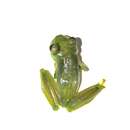Description
provided by AmphibiaWeb articles
Teratohyla midas is a small frog, with males having a snout-to-vent length of 17.4 - 19.2mm, and females having a snout-to-vent length of 20.6 - 25.6mm. The head is wider than the body, with a snout that appears shortened when viewed from the back and the sides. There is a rounded ridge that runs from the edge of the eye to the nostril, and the region between the eye and the nostril is curved outwards. The nostrils, which protrude towards the sides of the back, are located at the edge of the snout furthest from the center of the body, and the region the nostrils is slightly convex. The lips are rounded, and the eyes are fairly big and are faced towards the front and sides. The upper third of the tympanum is not visible, with the rest of the tympanum facing the sides of the back. There are no tubercles, and males lack humeral spines. Finger I is longer than Finger II, Finger III is longer than Finger IV, but no information is available on the relative lengths of all the fingers. There is primitive webbing between Fingers I and II. The discs on the fingers are shortened. The subarticular tubercles are tiny and round, the palmar tubercle is big, and there are no supernumerary tubercles. The legs are fairly thin. The legs have small subarticular tubercles, lengthened inner metatarsal tubercles, and no outer metatarsal or supernumerary tubercles. Two thirds of the foot is webbed, and there is no information available on the relative toe lengths. The toe discs are more rounded than the finger discs. The skin on the back is rough, and the skin on the underside is grainy. The rest of the body is smooth. The cloaca is located at the upper region of the thighs, with two large tubercles right beneath it (Lynch and Duellman 1973).Teratohyla midas looks similar to Rulyrana flavopunctata, but it is differentiated from R. flavopunctata by a truncate instead of rounded snout, and by having less webbing on its hands and feet. It also looks similar to Nymphargus siren, but it is differentiated from N. siren by having a less prominent tympanum that points towards the sides and the back instead of towards the sides and the posterior, and it has more webbing on its hands and feet (Lynch and Duellman 1973).In life, the entire backside is dark green with some gold fleck colorations on its sides, and has a white chest. The lining of the abdominal cavity is unpigmented, and it has green bones. The iris is silvery bronze with a black-netted pattern, and the hands and feet are a pale yellow-green color. In preservative, its entire backside is lavender with some white fleck colorations on its body. The rest of its body is creamy white (Lynch and Duellman 1973).There is no information available on variation within the species.The species authority is: Lynch, J.D. and Duellman, W.E. (1973). "A review of the centrolenid frogs of Ecuador, with descriptions of new species." Occasional Papers of the Musem of Natural History, University of Kansas, (16), 1-66.Mitochondrial analyses suggest that Teratohyla is sister to Rulyrana, whereas nuclear analyses suggest that Teratohyla is sister to a clade formed by Chimerella, Espadarana, Cochranella, Rulyrana, and Sachatamia (Guayasamin et al. 2009).The species name midas refers to a king in Greek mythology, who turned everything he touched into gold. This is a reference to the frog being found in Rio Aguarico, where gold has been found, and also a reference to the gold fleck coloration found on the frog (Lynch and Duellman 1973).
- Cisneros-Heredia, D. F., and McDiarmid, R. W. (2005). ''Amphibia, Centrolenidae, Centrolene peristictum, Centrolene prosoblepon, Cochranella cochranae, Cochranella midas, Cochranella resplendens, Cochranella spinosa, Hyalinobatrachium munozorum: range extensions and new provincial records.'' Check List. Journal of Species Lists and Distribution, 1, 18-22.
- Rodriguez, L., Martinez, J. L., Azevedo-Ramos, C., Coloma, L. A., Ron, S. 2004. Teratohyla midas. IUCN Red List of Threatened Species. Version 2012.2. www.iucnredlist.org. Downloaded on 07 February 2013.
- author
- Amanda Chiachi
- author
- Gordon Lau
Distribution and Habitat
provided by AmphibiaWeb articles
Teratohyla midas is found in Brazil, Ecuador, French Guiana, and Peru. It may also be found in southern Colombia, but there are no records to verify this. It is found in elevation from 200m - 360m. This species lives in lightly modified tropical forests and is often found on leaves and branches (Rodriguez et al. 2012).
- author
- Amanda Chiachi
- author
- Gordon Lau
Life History, Abundance, Activity, and Special Behaviors
provided by AmphibiaWeb articles
Teratohyla midas deposits its eggs on leaves above bodies of water, typically streams, where the tadpoles will be able to develop after hatching. As with most other Teratohyla species, Teratohyla midas only deposits its egg clutches on the upper sides of leaves (Cisneros-Heredia et al. 2009, Rodriguez et al. 2012).
- author
- Amanda Chiachi
- author
- Gordon Lau
Life History, Abundance, Activity, and Special Behaviors
provided by AmphibiaWeb articles
Teratohyla midas has a stable population trend. It is listed as a least concern amphibian because of its tolerance to habitat modification, and wide distribution. This species has large areas of habitat remaining although some habitat loss has occurred due to logging, agriculture, colonization, and the collection of wood. It is found in the Manu Reserve Zone in Peru as well as in conservation units and reserves in Brazil and Ecuador (Rodriguez et al. 2012).
- author
- Amanda Chiachi
- author
- Gordon Lau
Relation to Humans
provided by AmphibiaWeb articles
Teratohyla midas has been found in areas of human activity and disturbance (Rodriguez et al. 2012).
- author
- Amanda Chiachi
- author
- Gordon Lau

